The Lenovo ThinkPad A285 (12.5-Inch) Review: Ryzen Pro Gets Down to Business
by Brett Howse on December 18, 2018 8:00 AM EST- Posted in
- Laptops
- AMD
- Lenovo
- ThinkPad
- Vega
- Ryzen
- Ryzen PRO
- Ryzen Mobile
- Vega Mobile
Battery Life
Perhaps more than most devices, a small laptop like the ThinkPad A285 is more likely to be used away from the desk, and therefore battery life is fairly important. Lenovo offers a 48 Wh battery inside the 12.5-inch chassis, which like the Intel based ThinkPad X280, has moved away from the dual-battery system and moved to just a single battery which isn’t replaceable by the end-user. This lets Lenovo cut some size and weight, but one of the nice factors of the older models was an optional larger battery for those that needed it, or the ability to swap out the rear battery if needed.
To test the battery life we have several scenarios. Our 2013 battery life test is very light, and with today’s PCs is almost an idle rundown. The newer battery life test is much more CPU intensive, and generally is more representative of what you’d see for basic tasks. Finally, we test the laptop on movie playback. The display is calibrated to 200 nits to keep a consistent brightness across all devices.
2013 – Light
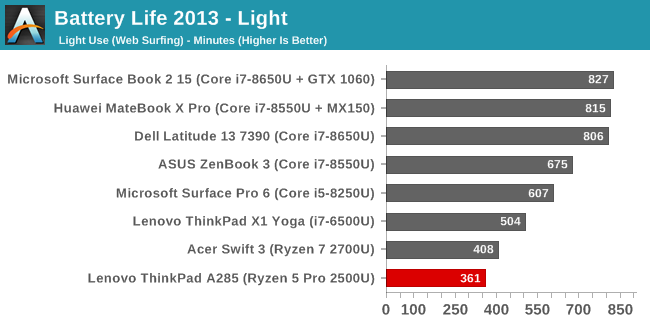
With just a 48 Wh battery, the ThinkPad A285 can’t compete, and sits right at the bottom with the worst battery life we’ve seen in a while, at just one minute over six hours. We’ll dig into why in a minute.
2016 – Web
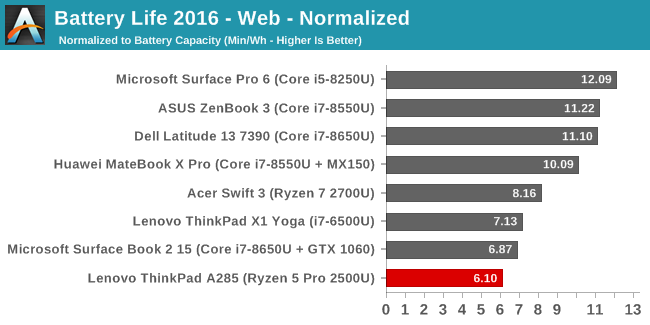
Our newer web test taxes the CPU quite a bit more, and generally knocks down the battery life significantly on any low-powered device. That is the case here, but the difference is not as dramatic as some of the other devices.
Movie Playback
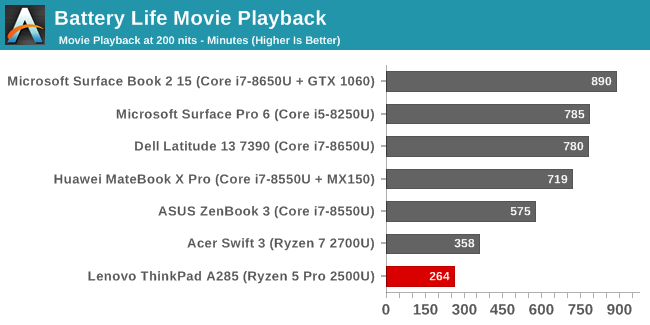
Generally movie playback is the most efficient test we have, but there’s something not right with Raven Ridge and movie playback. The decode can be offloaded to the media block, so in theory the CPU should be in its lowest power state for this test, but surprisingly the A285 fares worse here than in the web test. That result is mimicked by the other Raven Ridge laptop in our graph.
Normalized Results


Finally we remove the battery capacity from the equation to see how many minutes of battery life each device gets per Wh of battery. The Raven Ridge devices sit right at the bottom.
Digging Into Power Draw
On any system there are always various components drawing power at all times. The display is generally the highest power consumer on any system at idle, and the amount of energy it draws varies on the size, brightness, and resolution. For instance, the display of a Surface Book 2 15-inch draws about 7.65 Watts at 100% brightness. Setting the display down to 200 nits drops its power draw to 4.1 Watts. Meanwhile the rest of the system pulls just 1.43 Watts at idle.
Raven Ridge, it appears, has a power draw problem. We saw it on the Acer Swift 3, and we’re seeing it again on the Lenovo ThinkPad A285. The base power draw is quite high, which makes the battery deplete much more quickly than it should. Let’s look at some numbers:
For this test, we've set the display to 100% brightness while the rest of the system is idling, with Windows set to shut off the display after a couple of minutes. The graph above includes both the Surface Book 2 (Green/Blue) and the ThinkPad A285 (Red), plotting the total power draw of each system. Since the display itself is only on for a couple of minutes, the first part of the graph is with the display at 100%, while the remaining section of the graph shows the system's average idle power draw.
Breaking things down, we see that the ThinkPad A285 starts out with an average power draw of 8.62 Watts with its display on and the system idling. Waiting a few minutes for the display to turn off, and we see that the average system power consumption drops by just over 4 Watts to 4.6 Watts. This is a significant drop, but not significant enough. The Surface Book 2 in the same scenario idles at a little more than one-third of this, meaning the A285 – and specifically, the Raven Ridge platform inside – is drawing an additional 3 watts at full idle. This is a huge amount of power to draw at idle, and leads to the less than amazing battery life results on Raven Ridge devices.
Some of the draw will be from the DDR4 memory, since most Ultrabooks leverage LPDDR3 to reduce the power usage, but that is not going to be all of it. It looks like AMD has some work to do in order to get its power usage in check if they want to better compete in the laptop space. They need their Haswell moment.
Charge Time
The flip side of the coin is charge time, and Lenovo tends to offer quite quick charge rates. The ThinkPad A285 ships with a 65-Watt AC Adapter, which is much larger than the adapter that ships most laptops of this size, and it is rated to charge 80% of a charge in just 60 minutes. It connects via USB Type-C.
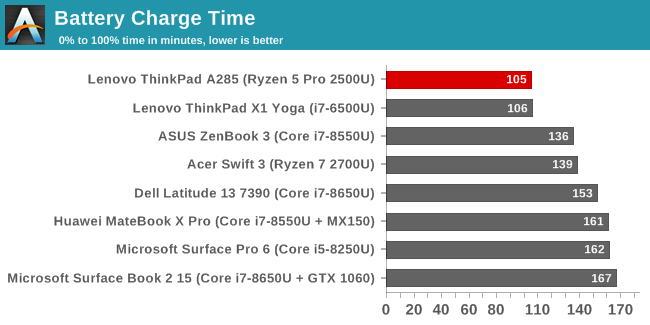
Not only does the 48 Wh battery get filled to 100% in the shortest amount of time, Lenovo even beats the 60 minute time for 80% by seven minutes.


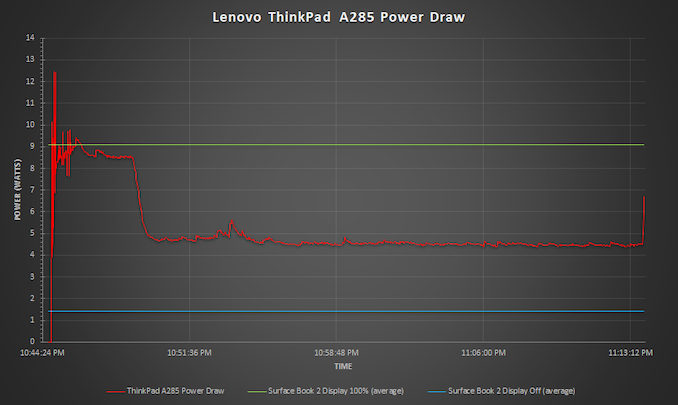
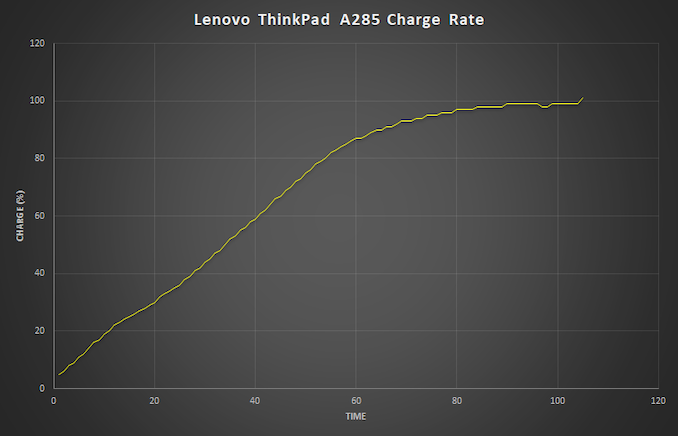








72 Comments
View All Comments
Brett Howse - Tuesday, December 18, 2018 - link
The Surface Book 2 was the device I had power draw numbers from for the idle power draw graph so I have no issues including it in the performance graphs as well. The CPU is a 15W i7. The GPU is of course more powerful but that's still a valid point since people may wonder how close Vega in an iGPU factor is coming to dGPUs.But the best part is that if you don't think it's important, you can just ignore that data point and compare against all the others. Or, click the links I provide to our Online Bench database and make any comparisons you prefer. We provide all the data.
QChronoD - Wednesday, December 19, 2018 - link
I think that many of the people who were complaining about that would accept the comparison if an estimated price of each machine was given at the beginning. If you knew before looking at the graphs that one of the laptops was 2x the price and it looks like being 2x as fast then everything is fine, but if you aren't aware of the price difference then it looks like this machine is a steaming pile.QChronoD - Wednesday, December 19, 2018 - link
Just for reference if anyone actually reads the comments:Microsoft Surface Book 2 15 - $2600
Dell Latitude 13" 2-in-1 7390 - $1800
Asus Zenbook 3 - $1500
Huawei Matebook X Pro - $1350
Lenovo ThinkPad X1 Yoga - $1500
Lenovo ThinkPad A285 - $1200
Microsoft Surface Pro 6 - $1000
Acer Swift 3 R7-2700U - $700
These are just quick prices off amazon trying to get similar specs.
IGTrading - Thursday, December 20, 2018 - link
I agree AnandTech provides "all the data" and that's of course laudable.But often times you can bury a good product in all that data. Comparing a 1200 USD notebook with 2600 USD notebooks is way beyond a stretch.
The potential buyer reading the review for a 1200 USD model is reading it for a reason: because that's what he wants (a 12" portable) or that's his budget (1200 USD) .
Ok ... you compare it with other similar sized notebooks that are also similarly priced ... such as 900 ~ 1400 USD ...
But I honestly have the feeling the results of the Lenovo AMD Ryzen-based notebook are buried in "all the data" ...
Like I've said ... this doesn't look like a review at all and also it doesn't look like a Round-Up (several notebook in a certain price range or with similar characteristics) ..
Going from 700 USD to 2600 USD as a price range ... And from 12" to 15" as a size range ... makes this look like somebody wanted to make the AMD Ryzen portable look slower than a notebook which is much larger and more than 200% more expensive ....
This is how a just comparison should look like in my view (Test Product vs. Similar Products in the Same Product Range vs. 1 product from the Upper Product Range as a comparison example) : https://hothardware.com/ContentImages/Article/2690...
And Ryzen did not beat the CPU+dGPU either ... nor did it ace all the tests ... but I never had the feeling of its results being buried in "all the data" ... just IMHO
kaidenshi - Tuesday, December 18, 2018 - link
Yep, two thin netbooks/ultrabooks I've had in the past had pop-down Ethernet ports, which were the same height as a USB-A port when not in use.thesavvymage - Tuesday, December 18, 2018 - link
honestly though, why do you need an ethernet port on the device? Its kinda just wasting space since its not like you plug that in separately, it should just be connected to whatever dock you have at someone's desk. If I had to plug in power, monitor, and ethernet separately every time I sat at my desk I'd go mad.Right now at work I'm using a macbook and its pretty simple to have all that plugged into a USB-C dock
SaolDan - Wednesday, December 19, 2018 - link
In my line of work i have to be able to connect to lightin controllers and switches thru ethernet out in the field so a Ethernet por would be required.The_Assimilator - Wednesday, December 19, 2018 - link
Not to mention that you have to fork out extra for the dongle!darkich - Tuesday, December 18, 2018 - link
.. a 768p TN entry level screen?Really? My goodness
PeachNCream - Tuesday, December 18, 2018 - link
12.5 inches. At 1080p on that size screen, scaling will be a thing and some software still sucks at scaling. Scaling will also mean that basically the same quantity of information can be displayed at the same time even if the resolution is higher. The GPU will work harder and consume more power while generating more heat to push pixels that do not benefit productivity.